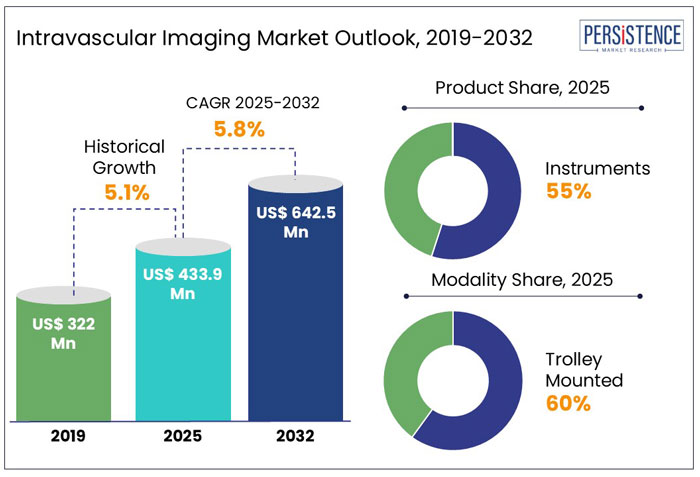ID: PMRREP33923| 188 Pages | 29 Jan 2025 | Format: PDF, Excel, PPT* | Healthcare

The intravascular imaging market is estimated to reach a size of US$ 433.9 Mn in 2025. It is predicted to rise at a CAGR of 5.8% through the assessment period to attain a value of US$ 642.5 Mn by 2032.
The global market is poised for substantial growth, fueled by technological developments and increasing need for accurate diagnostic tools in cardiovascular care. Global rise in the elderly population is significantly contributing to demand for intravascular imaging solutions, primarily due to the increased susceptibility of older adults to cardiovascular diseases (CVD).
By 2030, 1 in 6 people worldwide will be 60 years or over, rising from 1 billion in 2020 to 1.4 billion. By 2050, this figure is projected to double to 2.1 billion. The proportion of the global population aged 65 and above is likely to increase from 10% in 2022 to 16% by 2050. Adopting artificial intelligence in imaging technologies is set to enhance diagnostic capabilities, offering new opportunities for market growth.

Key Highlights of the Market
|
Market Attributes |
Key Insights |
|
Intravascular Imaging Market Size (2025E) |
US$ 433.9 Mn |
|
Projected Market Value (2032F) |
US$ 642.5 Mn |
|
Global Market Growth Rate (CAGR 2025 to 2032) |
5.8% |
|
Historical Market Growth Rate (CAGR 2019 to 2023) |
5.1% |
Europe stands out as a leading region in the global intravascular imaging market due to its proactive adoption of unique medical technologies. The region benefits from a well-established healthcare infrastructure that integrates innovative intravascular imaging solutions seamlessly.
With a strong focus on healthcare research and development, countries in Europe create an environment encouraging innovation and accelerating the adoption of next-generation imaging techniques. Developments in medical technology have positioned Europe as a frontrunner in the intravascular imaging sector.
The region continues to drive progress and set global standards by prioritizing cutting-edge imaging solutions to improve cardiovascular care. Europe’s commitment to enhancing patient outcomes through state-of-the-art intravascular imaging technologies solidifies its role as a key player in shaping the future of cardiovascular diagnostics and treatment. Owing to the aforementioned factors, the region is predicted to hold a share of 30% in 2025.
The market is segmented into instruments and software based on product type. Instruments are the dominant category, which are foundational in facilitating unique diagnostic procedures within the cardiovascular domain. The segment is anticipated to hold a share of 55% in 2025 and witness a CAGR of 5.8% through 2032.
Instruments include intravascular ultrasound (IVUS) catheters, optical coherence tomography (OCT) systems, and angiography equipment. These tools enable healthcare professionals to obtain high-resolution images of blood vessels, aiding in the precise assessment of vessel anatomy, plaque composition, and potential abnormalities.
The intravascular imaging industry is divided into handheld and trolley-mounted modalities. The trolley-mounted segment is the dominant one, with 60% of the market share in 2025.
Trolley-mounted intravascular imaging systems are favored in clinical settings due to their comprehensive features and robust capabilities. These systems typically offer superior imaging quality, novel diagnostic functionalities, and enhanced processing power compared to their handheld counterparts.
The design of trolley-mounted systems allows for the integration of larger displays and more sophisticated software, facilitating detailed visualization and analysis of vascular structures. The preference for trolley-mounted systems is particularly evident in hospitals and specialized cardiovascular centers, where the demand for high-precision imaging is paramount.
The ability to produce high-resolution images aids clinicians in making accurate diagnoses and informed decisions about patient care. Trolley-mounted systems' ergonomic design and mobility enable easy maneuverability within clinical environments, enhancing workflow efficiency.
Intravascular imaging represents a cutting-edge medical technology that revolutionizes cardiovascular diagnosis and intervention. This innovative approach involves specialized imaging techniques inside blood vessels to visualize the interior of arteries and veins.
Intravascular imaging primarily aims to provide detailed, real-time information about vessel structures, plaque buildup, and potential blockages. Intravascular ultrasound (IVUS) and optical coherence tomography (OCT) are integral to this diagnostic methodology.
Increasing prevalence of cardiovascular diseases and a rising demand for minimally invasive diagnostic procedures fuel market growth. Technological innovations, such as improved imaging resolution and the development of catheter-based imaging devices, drive innovation in this sector.
As the market evolves, collaborations between healthcare institutions, imaging technology developers, and ongoing research initiatives pave the way for continued developments. These are positioning intravascular imaging as a pivotal tool in modern cardiology.

Between 2019 and 2023, the intravascular imaging market experienced steady growth, driven by developments in medical imaging technology and rising prevalence of cardiovascular diseases. It witnessed a CAGR of 5.2% from 2019 to 2023.
During the historical period, there was an increased adoption of intravascular ultrasound (IVUS) and optical coherence tomography (OCT), propelled by rising demand for precision in diagnosing and treating coronary artery diseases. The global burden of cardiovascular disorders significantly influenced market growth, with countries like the U.S. and China witnessing high adoption due to enhanced healthcare infrastructure and awareness about early diagnosis.
Over the forecast period, the intravascular imaging industry is poised for transformative growth. Factors such as the integration of artificial intelligence (AI) into imaging technologies and surging focus on personalized medicine are likely to redefine the market landscape.
AI-driven intravascular imaging systems are anticipated to provide enhanced diagnostic capabilities, reducing human error and improving patient outcomes. The global shift toward outpatient care and ambulatory surgical centers will likely create new opportunities for portable imaging devices.
Rising Incidence of Cardiovascular Diseases
Rising incidence of cardiovascular diseases is a key driver propelling the intravascular imaging market. Cardiovascular diseases are the leading cause of mortality globally, responsible for approximately 17.9 million deaths annually, accounting for 32% of all deaths worldwide, according to the WHO.
As the global burden of cardiovascular disorders increases, there is a growing need for precise diagnostic tools to guide effective interventions. Intravascular imaging techniques are pivotal in assessing coronary artery diseases, vulnerable plaques, and stent optimization.
Surging cases of atherosclerosis and complex coronary lesions necessitate unique imaging solutions for accurate disease characterization. Intravascular imaging not only aids in diagnosis but also influences treatment strategies, contributing to improved patient outcomes. Increasing prevalence of cardiovascular diseases worldwide amplifies demand for intravascular imaging technologies, making it a vital factor driving the market's sustained growth.
Continuous Innovations in Imaging Technologies
Innovations such as intravascular ultrasound (IVUS) and optical coherence tomography (OCT) have revolutionized the landscape of cardiovascular diagnostics. Such unique imaging modalities provide high-resolution, real-time visualization of blood vessels, aiding in precise coronary anatomy and pathology assessment.
The ongoing development of miniaturized imaging devices and catheters enhances their applicability in various vascular procedures. As clinicians increasingly recognize the value of detailed intravascular imaging for accurate diagnoses and treatment planning, the market witnesses a surge in demand. Integrating AI into imaging analysis further augments diagnostic capabilities, propelling market growth.
Technological Complexity and Integration Challenges
The intravascular imaging market faces several challenges, primarily tied to the complexity of unique imaging devices and their integration into everyday clinical workflows. While revolutionary, emerging modalities like optical OCT and IVUS require continuous training for healthcare professionals to ensure proper usage and interpretation. Incorporating these cutting-edge technologies into existing systems often demands significant investments in staff education and infrastructure upgrades.
Interoperability issues between various imaging systems can make seamless data integration difficult, creating hurdles for healthcare providers aiming to streamline their operations. Addressing these challenges is essential to unlocking the full potential of intravascular imaging tools, enhancing patient outcomes, and encouraging their widespread adoption across clinical settings.
Rising Applications in Structural Heart Interventions
A promising growth opportunity in the intravascular imaging market lies in raising its applications to structural heart interventions. Integrating intravascular imaging into unique interventions allows healthcare providers to achieve greater precision in device placement, better procedural guidance, and more accurate post-procedural assessments.
Expansion into structural heart therapies meets the growing demand for unique cardiac care and positions intravascular imaging as a critical tool for comprehensive cardiovascular treatment. Leveraging these novel imaging technologies opens new avenues for revenue generation while addressing the evolving needs of modern cardiac care.
Integration of Artificial Intelligence for Image Analysis
Integrating AI algorithms into interpreting intravascular images is revolutionizing cardiovascular diagnostics by enhancing diagnostic accuracy, streamlining data processing, and alleviating the workload on healthcare professionals. With machine learning, subtle patterns and anomalies in vessel structures can be detected, enabling the early identification of cardiovascular diseases and significantly improving diagnostic precision.
Collaborations between imaging technology developers and AI specialists drive the creation of unique algorithms, paving the way for real-time, automated image analysis. Innovation optimizes clinical workflows and positions intravascular imaging as a cutting-edge solution in the evolving field of novel cardiovascular diagnostics. By combining AI with imaging technology, the market is unlocking new opportunities to enhance patient care and redefine the future of cardiovascular imaging.
Leading organizations such as Canon Medical Systems Corp., Boston Scientific Corp., GE Healthcare, and Philips drive innovation in the highly competitive intravascular imaging industry. They leverage competitive intelligence to gain a strategic advantage, which involves analyzing market trends, competitor strategies, and technological breakthroughs.
By understanding the dynamic market landscape, businesses can identify niche opportunities, anticipate industry shifts, and stay ahead of the innovation curve. The data-driven approach enables informed decision-making, optimized product development, and effective market positioning in a fast-evolving industry. Companies must align their strategies with technological developments, regulatory requirements, and changing customer expectations. Key components of a successful strategy include offering a diversified portfolio of imaging solutions, forming strong partnerships with healthcare providers, and extending into new geographic markets.
Recent Industry Developments
The market is estimated to increase from US$ 433.9 Mn in 2025 to US$ 642.5 Mn by 2032.
Innovative therapies, improved diagnostics, and increasing healthcare investments propel the industry.
Canon Medical Systems Corp., Boston Scientific Corp., GE Healthcare, Philips, and Siemens Healthcare are few of the leading industry players.
The market is projected to record a CAGR of 5.8% from 2025 to 2032.
Launch of targeted therapies, including complement inhibitors like zilucoplan is boosting market growth.
|
Attributes |
Details |
|
Forecast Period |
2025 to 2032 |
|
Historical Data Available for |
2019 to 2023 |
|
Market Analysis |
US$ Million for Value |
|
Key Country Covered |
|
|
Key Market Segments Covered |
|
|
Key Companies Profiled |
|
|
Report Coverage |
|
|
Customization & Pricing |
Available upon request |
By Product Type
By Modality
By End Use
By Region
Delivery Timelines
For more information on this report and its delivery timelines please get in touch with our sales team.
About Author